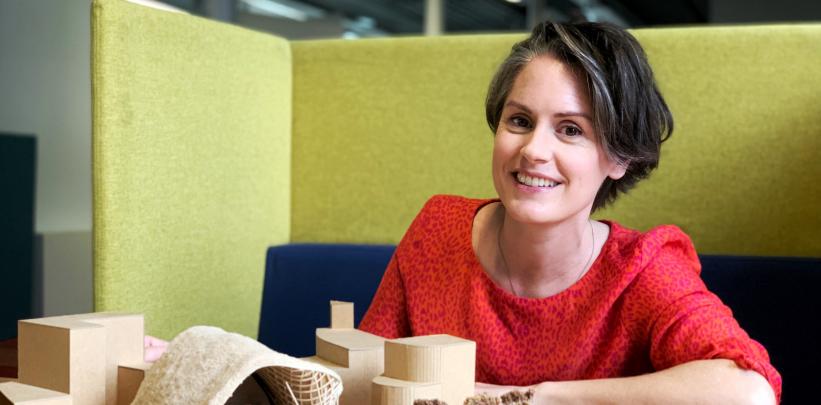Decomposable theatre design wins national architecture award for Unitec Masters student
A low-carbon and regenerative theatre design using bamboo, thatch, earth, and wheat straw has netted Unitec Masters student Abigail Spence the distinction award in the recent TEAM Architects Scholarship awards.
Abigail’s Te Whau Community Arts and Cultural Centre design was her response to a brief that called for a sustainable building for the Avondale creative community, including a 250-seat theatre, rehearsal spaces, staff areas, and a café.
TEAM Architects Scholarships are open to fourth-year architectural students from the three Schools of Architecture in Aotearoa, New Zealand. They are designed to assist them with completing their studies in their final year.
Pushing the limits in regenerative materials

Abigail used cultural mapping as the catalyst for her building design, using materials with a long history in the Pacific, India, and Asia and expressive the predominant cultures in the local Avondale community.
“The chosen form would be familiar to many people,” she says. “Large, thatched spaces suspended on columns can be seen all over the world, and materials like bamboo are common.
“Through my design, I also wanted to encourage students to push the limits of regenerative materials in theoretical projects,” Abigail says. “I experimented with many details for this project, and the TEAM staff questioned me on certain aspects, which was great. It was a learning experience for everyone.”
“I wanted to create something that wasn’t only sustainable but also regenerative,” she says. “It’s the difference between a building that limits the amount of environmental harm it causes and a building that leaves the environment better off.”
“I’ve designed it so the entire building would decompose, apart from the concrete foundations, which can be reused for another structure.”
Glen Frost, director of TEAM Architects NZ and a member of the judging panel, says: “Abigail’s Te Whau Community Theatre proposal would provide a much-needed heart for Avondale to reflect and serve its community well, leaving only a trace of a footprint both in its use and at the end of its life.
“I congratulate her on delivering such a rigorously considered project.”
The design brings Unitec research to life.

The curving roof of Abigail’s design is constructed using a bamboo grid shell structure, and the roof is thatched with wheat straw, a by-product from food production that is normally burnt off or discarded. On one side, the roof slopes into a spiral, encouraging water run-off into a broad grass channel where it is filtered before being used for the buildings’ grey water. A bamboo grove on the opposite site grows new material to replace the external columns.
On the eastern side of the construction, a thick rammed earth wall in the reception area moderates the building’s internal temperature. The rest of the walls are prefabricated straw bale panels modelled on Project Pātūtū, a Unitec research project led by Unitec Architecture lecturer Min Hall.
Project Pātūtū is investigating how a valuable but underutilised resource — straw from the cereal grain growing industry — can be used to produce wall panels for houses on a large scale.
“It’s encouraging to see Abigail continuing her interest in low-carbon materials and the research we’ve been carrying out at Unitec over the past five years,” says Ms. Hall.
“Abigail has taken this one step further by imagining how straw bale wall panels might be used for a single large-scale building. Her concept for a community theatre is bold and explores using the panels for very tall walls, which make the most of the acoustic properties of straw.
“Her concept is really valuable for the research we’re doing, but more importantly, seeing a student taking the issue of reducing the carbon footprint of our built environment so seriously is hugely encouraging.”
Pushing the boundaries of non-indigenous design
“Designing with well-documented materials like concrete with steel trays is predictable,” says Abigail.
“I wanted to know how far I could push Min’s straw bale panel concept. There’s a lot of great research taking place at Unitec and many students aren’t aware of these projects.
“I’m also passionate about knowing how to design well as a non-indigenous person working in an indigenous country,” she says.
“That’s what my current thesis idea grew out of — the discontent I felt during this project. I knew I was designing on land with a strong Māori history for a largely tauiwi (non-Māori) community to use potentially.
“I didn’t feel like I had all the tools I needed, so this year, I’m focusing on developing some as part of my thesis.
“I’m keen to explore how being a good Te Tiriti partner can help shape my design practice.”
Abigail, previously an account manager for a design company, is working part-time for Parnell-based residential firm Bourke Architects while she completes her studies.
